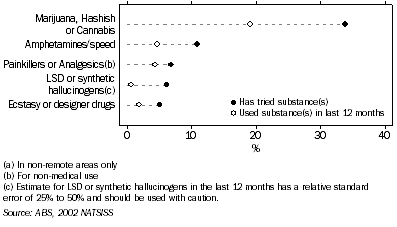The term ‘illicit drugs’ refers to a variety of substances that are either illegal to possess (e.g. heroin) or legally available, but used inappropriately (e.g. misuse of prescription medication, inhalation of petrol) (AIHW 2004b). The use of illicit drugs is linked to various medical conditions for individuals. Injecting drug users, for example, have an increased risk of blood-borne viruses such as hepatitis or HIV. For communities, there is increased potential for social disruption, such as that caused by domestic violence, crime and assaults (Gray et al. 2002; McAllister & Makkai 2001).
The 2002 NATSISS provides the most recent information on illicit substance use within the Indigenous population. However, due to data quality concerns associated with the method used to collect substance use data from respondents in remote areas, the statistics presented in this chapter are limited to Indigenous people living in non-remote areas.
The 2002 NATSISS shows that one-quarter (24%) of Indigenous people aged 15 years or over in non-remote areas reported having recently used an illicit substance (that is, they had used a substance in the 12 months prior to interview) and 40% reported having tried at least one illicit substance in their lifetime. Information on frequency of substance use was not collected.
Substance use was more prevalent among Indigenous males, of whom 43% had tried illicit drugs (compared with 37% of females) and 27% had used at least one substance in the last 12 months (compared with 21% of females). Indigenous people aged 25-34 years were the most likely to have ever tried substances (55%), whereas recent substance use peaked among those aged 15-24 years (30%).
As shown in graph 8.5, marijuana was the most commonly reported illicit drug used by Aboriginal and Torres Strait Islander people in 2002. One-third (34%) reported having tried marijuana and 19% had used it in the last 12 months. Amphetamines/speed and painkillers or analgesics (for non-medical use) were the next most frequently reported substances either experimented with or recently used by Indigenous Australians.
8.5 Illicit substance use, Indigenous persons aged 15 years or over(a) - 2002

Substance use alone was not directly associated with poorer self-assessed health in 2002. Similar rates of excellent or very good health (41% compared with 43%) and fair or poor health (24% compared with 25%) were reported among those who had recently used substances and those who had never used substances.
However, substance use was associated with other health risk factors. For example, Indigenous people who had used substances in the last 12 months were more likely than those who had never used substances to regularly smoke (69% compared with 39%) and to usually consume alcohol at risky or high risk levels (25% compared with 9%). They were also more than twice as likely to have been a victim of physical or threatened violence in the last 12 months (41% compared with 18%).
Although no direct comparisons can be made between Indigenous and non-Indigenous people in 2002, the 2001 NDSHS showed that Indigenous respondents aged 14 years or over were one and a half times as likely as non-Indigenous respondents to have tried illicit substances and were nearly twice as likely to have used them in the last 12 months (AIHW 2003a).
 Print Page
Print Page
 Print All
Print All